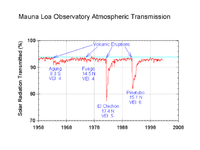
Photo from wikipedia
Introduction: Many factors can affect dry powder inhalers' (DPIs) aerosol emission and lung deposition. The fluctuation of environmental temperature and relative humidity (RH) that inhalers experience in realistic daily use… Click to show full abstract
Introduction: Many factors can affect dry powder inhalers' (DPIs) aerosol emission and lung deposition. The fluctuation of environmental temperature and relative humidity (RH) that inhalers experience in realistic daily use has not been extensively evaluated. This work aimed to evaluate the delivered dose (DD) and aerodynamic particle size distribution (APSD) of tiotropium Handihaler DPI (H) after exposure to patients' real‐life use environments. Methods: Ethical approval was obtained to enrol adult patients already using H. Patients who gave written consent were given new H to use and HygroLog temperature and RH data loggers to keep in the vicinity of the given inhaler. The H and HygroLog were returned after 2 weeks. Patient recruitment was done during the summer (HS) and winter (HW). As control, other HC were stored as per the leaflet storage instructions. The Next Generation Impactor was used to evaluate the inhalers. Results: The HC were stored under an average of 21.0 °C and 46.9% RH. The patients' HS and HW lived in an average (range) temperature (°C) 23.2 (18.3–38.2) and 17.8 (13.5–24.6), respectively, and RH 50.8% (24.3–65.3%) and 50.4% (30.6–72.4%), respectively. All H groups had comparable environments (p > 0.05). The HC, HS and HW gave similar tiotropium DD (&mgr;g) 7.60, 8.01 and 7.61, respectively (p > 0.05). Moreover, the fine particle dose &mgr;g (median diameter (&mgr;m)) were HC 2.41 (3.84), HS 2.55 (3.81) and HW 2.37 (3.83) (p > 0.05). Conclusions: The aerosol emission behaviour of tiotropium Handihaler was tolerant to real‐life retention environments of patients in Amman, Jordan. Graphical abstract Figure. No Caption available.
Journal Title: European Journal of Pharmaceutical Sciences
Year Published: 2019
Link to full text (if available)
Share on Social Media: Sign Up to like & get
recommendations!